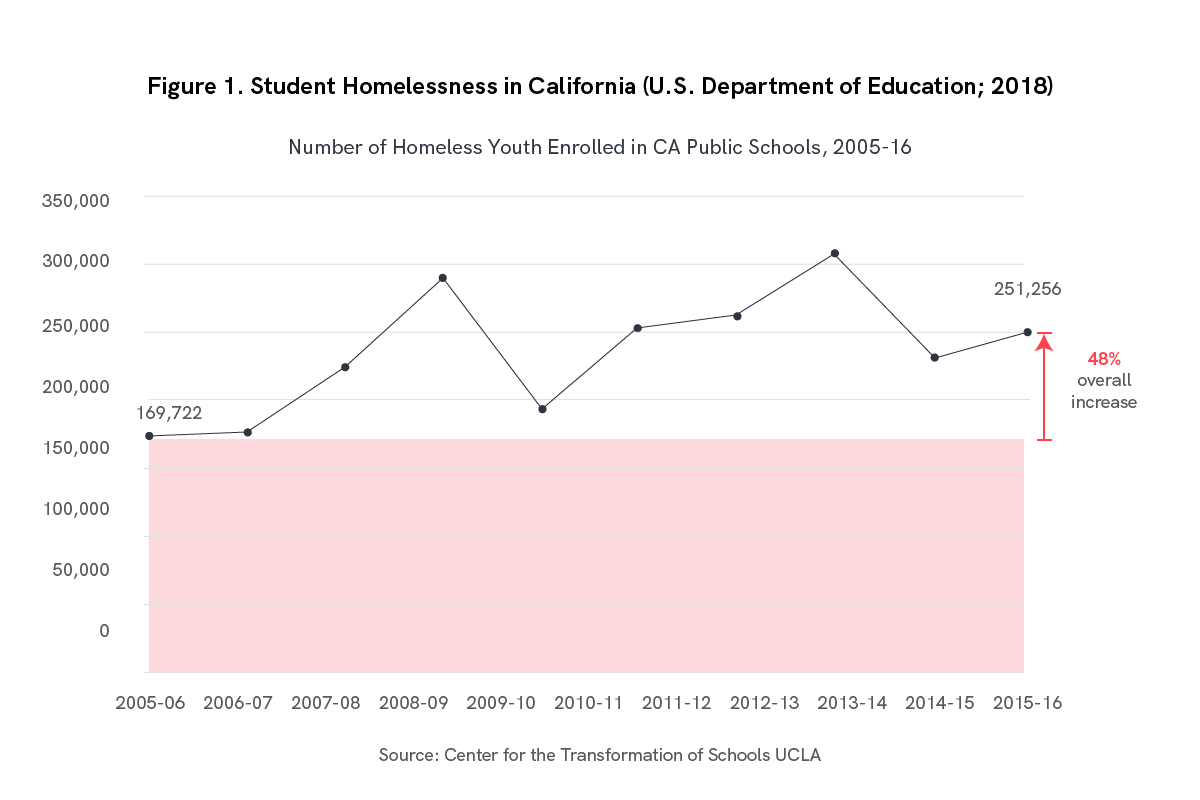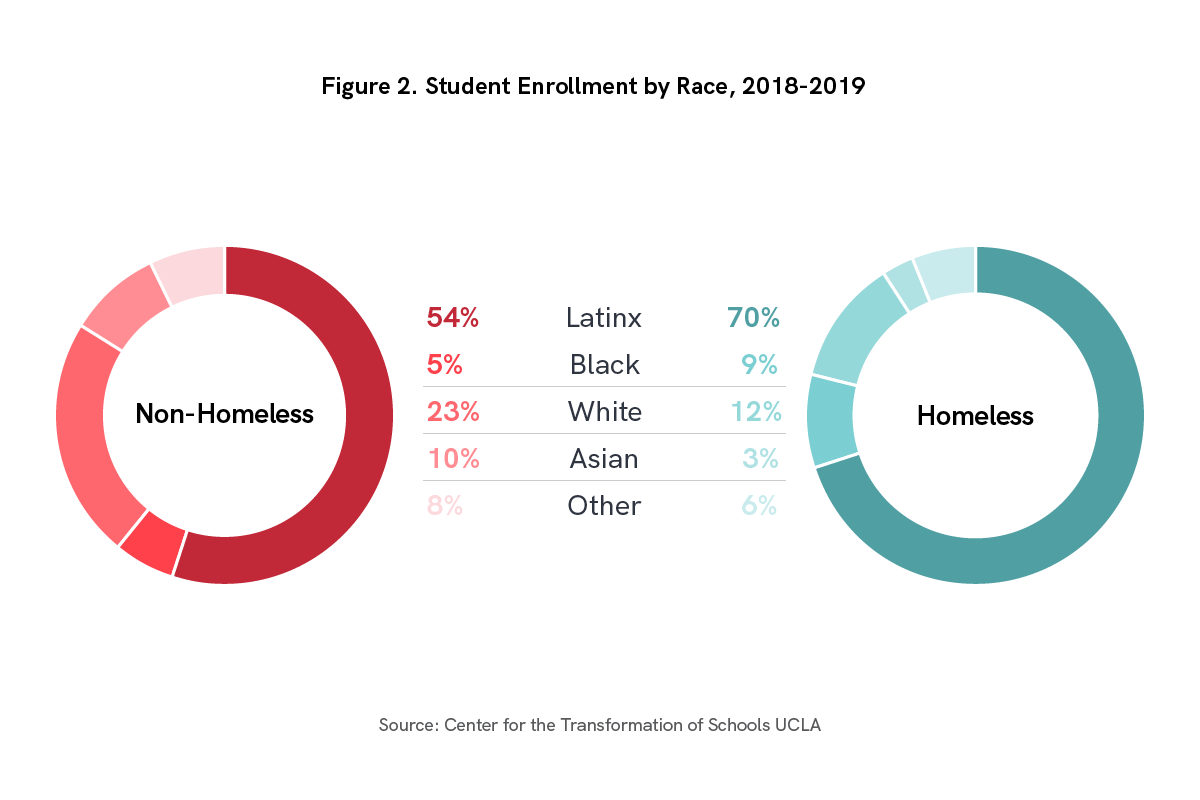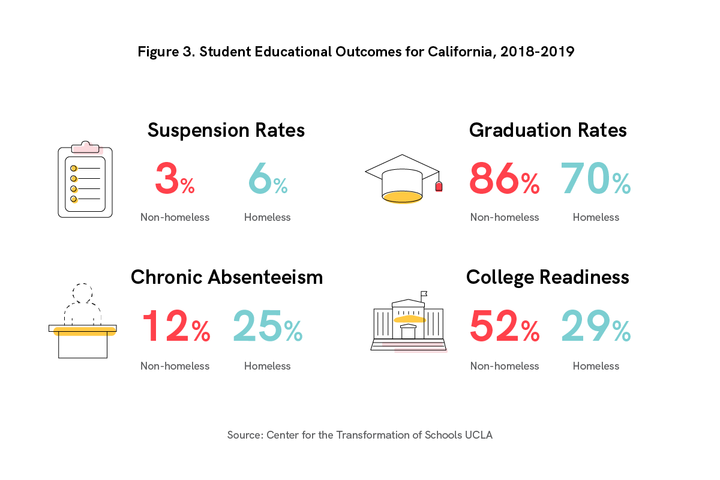Oct 20, 2020 · 8 min read
An Invisible Crisis: Shining a Light on Students Experiencing Homelessness

In the decade prior to 2016, the state of California registered a 48 percent increase in student homelessness, according to the U.S. Department of Education. As gut-wrenching as that upswing is, the crisis is likely even more alarming than the data suggests.
Many students live with near-constant housing insecurity, where any unexpected development could destabilize their lives. A sudden death in the family may force them to move in with an aunt or older sibling. Overwhelming expenses from an accident might mean a family is pushed out of a school district when they can’t make rent. Students may move cities repeatedly as their parents search for work. All of this is invisible in the Department of Education’s headcount.
It’s also important to note that students experiencing homelessness are disproportionately Latinx, Black, and LGBTQ-identifying. Latinx students make up 55 percent of the overall public school population in California—but represent 70 percent of its students experiencing homelessness. Only six percent of students overall are Black – yet nine percent of students experiencing homelessness are. And of the 1.6 million youth who experience homelessness nationally, an estimated 20 to 40 percent identify as LGBTQ. Now, COVID-19 has accelerated these preexisting inequities—and is poised to make this crisis even worse.
At CZI, we’re committed to make sure these students and their experiences aren’t overlooked. We’re proud to support a report from UCLA’s Center for the Transformation of Schools that includes not only crucial data and policy recommendations, but the voices and personal experiences of students experiencing homelessness.

We sat down with Lorena Camargo Gonzalez, a co-author of the report “State of Crisis: Dismantling Student Homelessness in California” to discuss what she learned from the 150+ stakeholders interviewed for the report, what a school system that successfully supports its students experiencing homelessness looks like, and why talking about instability is something we all need to get comfortable with in order to enact change.
What preconception is important to get rid of when it comes to understanding and recommending policies to support students experiencing homelessness?
Homelessness is not experienced just by what we see as a stereotypical homeless person, but by a lot of families who are one day or one month or one bill away from experiencing housing instability. It is really a nuanced experience.
In fact, there are so many circumstances that create housing instability that many students and their families don’t even know that they technically qualify as homeless. They might be crowded into one room of a temporary housing situation with a bunch of other people, but they don’t think of themselves as experiencing homelessness because they at least have somewhere to sleep that night. They may not know that they qualify for resources and support.

Could you give an example of the dynamics or events that could put a family or a student in an unstable housing situation?
Something out of their control happens. Sometimes it’s a natural crisis—after the fires in Butte County in 2017, the rate of student homeless jumped from about 3 percent to 17 percent. Or it may be an accident, or job loss, or having to pay high insurance premiums. If they are already from low socio-economic backgrounds, then they don’t have financial safety nets, and they resort to having to double up housing, when they move in with another family. Or they might just move because they can no longer pay rent. It’s important to have an understanding that homelessness is not really a siloed experience; it’s part of other, larger systemic issues.
What resources exist to support students experiencing homelessness, and are they enough?
It really depends. There are no state dedicated funds in CA for students experiencing homelessness. So most of the grant money comes from the federal McKinney-Vento Act (MVA), which says students experiencing homelessness can’t be denied a public education.
Usually what gets funded is training educators and connecting students to larger agencies. Direct services provided might include transportation vouchers, or referrals to housing. But the problem is, fewer than 10 percent of school districts in California receive the MVA money they need — and about two-thirds of the students experiencing homelessness in the state have no access to this funding. There just aren’t enough dollars to truly support our students.
Does that training—if they get it—adequately prepare educators to support students experiencing homelessness?
This is part of a larger issue of how much we throw onto our educators. We really do need to support our educators more. A lot of them don’t receive racial literacy training or social-emotional learning (SEL) preparation. They’re not trained to know how to identify students experiencing housing insecurity. The very people that students interact with every day sometimes may not know that they’re experiencing any instabilities.

In your research, were you impressed by any particular school or a district’s efforts to support students and families?
Yes, one in particular: Orange County. Their director for student homelessness is a full-time role. They’re not splitting their time between homeless youth and foster youth, which is usually what happens. It makes a world of a difference to have a dedicated person who is only focused on homelessness at the county level. Designated officials who are very knowledgeable about the systems and have the resources to support these families are more effective.
On top of that, Orange County has something called a ‘one-door strategy’. Normally, parents might go to one office seeking support, and then be referred to another office, and then to a housing office. In Orange County, they compile a list of where a family should start, so they don’t have to knock on every door and keep explaining their situation and reliving their traumas. They can get help right away.
How has the pandemic impacted your findings and how will it continue to do so?
With COVID, the issue is that a lot of students rely on the school physical buildings and physical services that they received there. They spend six to eight hours in one place. That might be the most stability that they have in their day. So, the little sense of stability that they may have had is gone.
Schools and districts already had issues identifying students who were experiencing homelessness in order to connect them with support. With COVID, they have even less of an ability to do so. Some educators are saying, “We don’t know what happened to them. We don’t know how to reach them. We don’t know where to find them.”
Where is it important to allocate resources?
There need to be dedicated funds for homelessness from the state, just like there are for foster youth or migrant education. These student homelessness numbers are growing. And we foresee that after COVID, they’ll grow even more. We’ll see the repercussions across the nation of folks losing their jobs and experiencing more displacement from their homes.

Where would you like to see more attention being paid?
We need to ask, ‘How do we prevent this?’ Right now, to qualify for support, you need to demonstrate that you haven’t had a home for months. It’s a response to something, versus prevention. A lot of these families are one bill away from being on the street and sometimes they only need assistance for one month. But they cannot get it. And because they’re not able to get preventative resources, they have to leave their homes. They have to wait until they’re on the street to get resources. That’s a big part of the problem.
Are you alone in this work?
We are part of a cohort of six other states who are looking at students experiencing homelessness. We find that we have a lot of the same challenges. It always goes back to 1. Identification, 2. Not having enough resources, 3. Not being able to access resources. But we are moving in the right direction because when you have all these different entities communicating and sharing with each other, then they’re more able to effectively support these students and their families.
You can learn more about Lorena Camargo Gonzalez’s research and the findings and recommendations of the Center for the Transformation of Schools at UCLA in the report “State of Crisis: Dismantling Student Homelessness in California”. Read the full report here.





